Notes For All Chapters Science Class 10 CBSE
Control and Co-ordination in Animals: Nervous system and endocrine system.
In animals, the nervous system and hormonal system are responsible for control and co¬ordination.
Receptors: Receptors are the specialized tips of the nerve fibres that collect the information to be conducted by the nerves.
Receptors are in the sense organs of the animals.
These are classified as follows :
- Phono-receptors: These are present in inner ear.
Functions: The main functions are hearing and balance of the body. - Photo-receptors: These are present in the eye.
Function: These are responsible for visual stimulus. - Thermo-receptors: These are present in skin.
Functions: These receptors are responsible for pain, touch and heat stimuli.
These receptors are also known as thermoreceptors. - Olfactory-receptors: These are present in nose.
Functions: These receptors receive smell. - Gustatory-receptors: These are present in the tongue.
Functions: These helps in taste detection.
Nervous System: The nervous system is composed of specialized tissues, called nervous tissue. The nerve cell or neuron is the functional unit of the nervous system. It is the nervous system which is mainly responsible for control and coordination in complex animals.
Functions of the nervous system
- Nervous system receives information from the environment.
- To receive the information from the various body.
- To act according to through muscles and glands.
A neuron is the structural and functional unit of the nervous system.
Neuron: Neuron is a highly specialized cell which is responsible for the transmission of nerve impulses. The neuron consists of the following parts
(i) Cyton or cell body: The cell body or cyton is somewhat star-shaped, with many hair like structures protruding out of the margin. These hair-like structures are called dendrites. Dendrites receive the nerve impulses.
(ii) Axon: This is the tail of the neuron. It ends in several hair-like structures, called axon terminals. The axon terminals relay nerve impulses.
(iii) Myelin sheath: There is an insulator cover around the axon. This is called myelin sheath. The myelin sheath insulates the axon against nerve impulse from the surroundings.
Types of neuron
- Sensory neuron: These neurons receive signals from a sense organ.
- Motor neuron: These neurons send signals to a muscle or a gland.
- Association or relay neuron: These neurons relay the signals between sensory neuron and motor neuron.
Synapse: The point contact between the terminal branches of axon of one neuron with the dendrite of another neuron is called synapse.
Neuromuscular Junction (NMJ): NMJ is the point where a muscle fibre comes in contact with a motor neuron carrying nerve impulse from the control nervous system.
Transmission of nerve impulse: Nerve impulses travel in the following manner from one neutron to the next :
Dendrites → cell body → axon → nerve endings at the tip of axon → synapse → dendrite of next neuron.
Chemical released from axon tip of one neuron, cross the synapse or neuromuscular junction to reach the next cell.
Human Nervous System: The nervous system in humans can be divided into three main parts
1. Central Nervous System: The central nervous system is composed of the brain and the spinal cord. The brain controls all the functions in the human body. The spinal cord works as the relay channel for signals between the brain and the peripheral nervous system.
2. Peripheral Nervous System: The peripheral nervous system is composed of the cranial nerves and spinal nerves. There are 12 pairs of cranial nerves. The cranial nerves come our of the brain and go to the organs in the head region. There are 31 pairs of spinal nerves. The spinal nerves come out of the spinal cord and go to the organs which are below the head region.
3. Autonomous Nervous System: The autonomous nervous system is composed of a chain of nerve ganglion which runs along the spinal cord. It controls all the involuntary actions in the human body. The autonomous nervous system can be divided into two parts :
- Sympathetic nervous system.
- Parasympathetic nervous system.
Sympathetic Nervous System: This part of the autonomous nervous system heightens the activity of an organ as per the need. For example, during running, there is an increased demand for oxygen by the body. This is fulfilled by an increased breathing rate and increased heart rate. The sympathetic nervous system works to increase the breathing rate the heart rate, in this case.
Parasympathetic Nervous System: This part of the autonomous nervous system slows the down the activity of an organ and thus has a calming effect. During sleep, the breathing rate slows down and so does the heart rate. This is facilitated by the parasympathetic nervous system. It can be said that the parasympathetic nervous system helps in the conservation of energy.
Human Brain: Human brain is a highly complex organ, which is mainly composed of nervous tissue. The tissues are highly folded to accommodate a large surface area in less space. The brain is covered by a three-layered system of membranes, called meninges. Cerebrospinal fluid is filled between the meninges. The CSF providers cushion the brain against mechanical shocks. Furthermore, protection. The human brain can be divided into three regions, viz. forebrain, midbrain and hindbrain.
Parts of Human Brain :
- Fore-brain: It is composed of the cerebrum.
- Mid-brain: It is composed of the hypothalamus.
- Hind-brain: It is composed of the cerebellum, pons, medulla, oblongata.
Some main structures of the human brain are explained below :
Cerebrum: The cerebrum is the largest part in the human brains. It is divided into two hemispheres called cerebral hemispheres.
Functions of cerebrum
- The cerebrum controls voluntary motor actions.
- It is the site of sensory perceptions, like tactile and auditory perceptions.
- It is the seat of learning and memory.
Hypothalamus: The hypothalamus lies at the base of the cerebrum. It controls sleep and wake cycle (circadian rhythm) of the body. It also controls the urges for eating and drinking.
Cerebellum: Cerebellum lies below the cerebrum and at the back of the whole structure. It coordinates the motor functions. When you are riding your bicycle, the perfect coordination between your pedalling and steering control is achieved by the cerebellum.
- It controls posture and balance.
- It controls the precision of voluntary action.
Medulla: Medulla forms the brain stem, along with the pons. It lies at the base of the brain and continues into the spinal cord. The medulla controls various involuntary functions, like hear beat respiration, etc.
It controls involuntary actions.
Example: Blood pressure, salivation, vomiting.
Pons: It relays impulses between the lower cerebellum and spinal cord, and higher parts of the brain like the cerebrum and midbrain, also regulates respiration.
Spinal cord: Spinal cord controls the reflex actions and conducts massages between different parts of the body and brain.
Reflex Action: Reflex action is a special case of involuntary movement involuntary organs. When a voluntary organ is in the vicinity of sudden danger, it is immediately pulled away from the danger to save itself. For example, when your hand touches a very hot electric iron, you move away your hand in a jerk. All of this happens in flash and your hand is saved from the imminent injury. This is an example of reflex action.
Reflex Arc: The path through which nerves signals, involved in a reflex action, travel is called the reflex arc. The following flow chart shows the flow of signal in a reflex arc.
Receptor → Sensory neuron → Relay neuron → Motor neuron → Effector (muscle)
The receptor is the organ which comes in the danger zone. The sensory neurons pick signals from the receptor and send them to the relay neuron. The relay neuron is present in the spinal cord. The spinal cord sends signals to the effector via the motor neuron. The effector comes in action, moves the receptor away from the danger.
The reflex arc passes at the level of the spinal cord and the signals involved in reflex action do not travel up to the brain. This is important because sending signals to the brain would involve more time.
Although every action is ultimately controlled by the brain, the reflex action is mainly controlled at the level of spinal cord.
Protection of brain and spinal cord
Brain is protected by a fluid filled balloon which acts as shocks absorber and enclosed in cranium (Brain box)
Spinal chord is enclosed in vertebral column.
Muscular Movements and Nervous Control: Muscle tissues have special filaments, called actin and myosin. When a muscle receives a nerve signal, a series of events is triggered in the muscle. Calcium ions enter the muscle cells. It result in actin and myosin filaments sliding towards each other and that is how a muscle contracts. Contraction in a muscle brings movement in the related organ.
Endocrine System: The endocrine system is composed of several endocrine glands. A ductless gland is called endocrine gland. Endocrine gland secretes its product directly into the bloodstream. Hormones are produced in the endocrine glands. Hormone is mainly composed of protein. Hormones assist the nervous system in control and co-ordination. Nervous do not react to every nook and corner of the body and hence hormones are needed to affect control and coordination in those parts. Moreover, unlike nervous control, hormonal control is somewhat slower.
Hormones: These are the chemical messengers secreted in very small amounts by specialised tissues called ductless glands. They act on target tissues/organs usually away from their source. Endocrine System helps in control and coordination through chemical compounds called hormones.
Endocrine Gland: A ductless gland that secretes hormones directly into the bloodstream.
| Endocrine Gland | Location | Hormones Produced | Functions |
| Pituitary gland (also known as the master gland) | At the base of the brain | Growth hormone (GH). Thyroid stimulating hormone (TSH). Follicle stimulating hormone (FSH) | GH stimulates growth. TSH stimulates the functioning of the thyroid gland. FSH stimulates the follicles during ovulation. |
| Thyroid Gland | Neck | Thyroxine | Controls general metabolism and growth in the body. |
| Adrenal gland | Above kidneys | Adrenalin | Prepares the body for emergency situations and hence is also called ‘Fight and flight’ hormone. |
| Pancreas | Near stomach | Insulin | Controls blood sugar level |
| Testis (male) | In Scrotum | Testosterone | Sperm production, development of secondary sexual characters during puberty. |
| Ovary (female) | Near uterus | Oestrogen | Egg production, development of secondary sexual characters during puberty. |
Iodised salt is necessary because: Iodine mineral is essential part of thyronine hormone so it is important that we must consume iodised salt as in turn it is essential for thyroid gland as it controls carbohydrate, proteins and fat metabolism for best balance of growth deficiency of iodine might cause disease called goitre.
Diabetes: Cause : It is due to deficiency of insulin hormone secreted by pancreas that is responsible to lower/control the blood sugar levels.
Treatment : Patients have to internally administer injections of insulin hormone which helps in regulating blood-sugar level.
In case of flight or fight reaction to an emergency situation, Adrenal glands → release adrenaline into blood → which acts on heart and other tissues → causes faster heart beat → more oxygen to muscles → reduced blood supply to digestive system and skin → diversion of blood to skeletal muscles → increase in breathing rate.
Feedback mechanism: A type of self-regulating mechanism in which the level of one substance in body influences the level of another.
Control and Co-ordination in Plants: Movements in plants and plant harmones.
Co-ordination in Plants: Unlike animals, plants do not have a nervous system. Plants use chemical means for control and co-ordination. Many plant hormones are responsible for various kinds of movements in plants. Movements in plants can be divided into two main types :
- Tropic movement
- Nastic movement
1. Tropic Movement: The movements which are in a particular direction in relation to the stimulus are called tropic movements. Tropic movements happen as a result of growth of a plant part in a particular direction. There are four types of tropic movements.
(i) Geotropic movement: The growth in a plant part in response to the gravity is called geotropic movement. Roots usually show positive geotropic movement, i.e. they grow in the direction of the gravity. Stems usually show negative geotropic movement.
(ii) Phototropic Movement: The growth in a plant part in response to light is called phototropic movement. Stems usually show positive phototropic movement, while roots usually show negative phototropic movement. If a plant is kept in a container in which no sunlight reaches and a hole in the container allows some sunlight; the stem finally grows in the direction of the sunlight. This happens because of a higher rate of cell division in the part of stem which is away from the sunlight. As a result, the stem bends towards the light. The heightened rate of cell division is attained by increased secretion of the plant hormone auxin in the which is away from sunlight.
(iii) Hydrotropic Movement: When roots grow in the soil, they usually grow towards the nearest source of water. This shows a positive hydrotropic movement.
(iv) Thigmotropism Movement: The growth in a plant part in response to touch is called thigmotropism movement. Such movements are seen in tendrils of climbers. The tendril grows in a way so as it can coil around a support. The differential rate of cell division in different parts of the tendril happens due to action of auxin.
2. Nastic Movement: The movement which do not depend on the direction from the stimulus acts are called nastic movement. For example, when someone touches the leaves of mimosa, the leaves droop. The drooping is independent of the direction from which the leaves are touched. Such movements usually happen because of changing water balance in the cells. When leaves of mimosa are touched, the cells in the leaves lose- water and become flaccid, resulting in drooping of leaves.
Plant hormones: Plant hormones are chemical which help to co-ordinate growth, development and responses to the environment.
Type of plant hormones: Main plant hormones are
- Auxin: (Synthesized at shoot tip).
Function: Helps in growth.
Phototropism: more growth of cells towards the light. - Gibberellin: Helps in the growth of the stem.
- Cytokinins: Promotes cell division.
- Abscisic acid: Inhibits growth, cause wilting of leaves. (Stress hormone)
Control and Coordination in Plants
- Stimuli: The change in the environment to which an organism responds.
- Co-ordination: Working together of various organs of an organism in a systematic manner to produce a proper response.
- Phyto-hormones: These are plant hormones.
- Auxin: It is a plant hormone which promotes cell enlargement and growth in plants.
- Gibberellins: A plant hormone which promotes cell differentiation and breaking dormancy of seeds and buds.
- Cytokinin: A plant hormone which promotes cell division and the opening of stomata.
- Abscisic Acid: It helps in inhibiting the growth of the plant and promotes wilting and falling of leaves and food.
- Tropism: A growth movement of a plant which determines direction with the stimulus.
- Nastism: A growth movement of a plant which does not determine direction with a stimulus.
- Phototropism: Movement of plants towards a light.
- Geotropism: Movement of plants towards the gravity of earth.
- Chemotropism: Movement of plants towards chemicals.
- Hydrotropism: Movement of plants towards the water.
- Thigmotropism: Movement of plants towards a response to the touch of an object.
Control and Coordination in Animals
- Stimuli: The change in the environment to which the organism responds.
- Co-ordination: Working together of various organs of an organism in a systematic manner to produce a proper response.
- Neuron: Functional unit of the nervous system.
- Synapse: A microscopic gap between a pair of adjacent neurons.
- Receptor: A cell in a sense organ which is sensitive to stimuli.
- Motor nerves: It carries the message from the brain to body parts for action.
- Sensory nerves: It carries the message from body to brain.
- Olfactory receptor: It detects smell by the nose.
- Gustatory receptor: It detects taste by a tongue.
- Thermoreceptor: It detects heat and cold by a skin.
- Photoreceptor: It detects light by eye.
- Reflex action: Sudden movement or response to the stimulus which occurs in a very short duration of time and does not involve any will or thinking of the brain.
- Brain: An organ present in the skull which controls and regulates the activity of the whole body and is known as president of the body.
- Cerebrum: Main thinking part of brain present in the forebrain area which controls all voluntary actions.
- Cerebellum: It is present in the hindbrain area and helps in maintaining posture and balance of the body.
- Medulla: It is present in the hindbrain area and helps in controlling voluntary actions of the brain.
- Spinal cord: It is a cylindrical structure of nerve fibres enclosed in the vertebral column which helps in the conduction of nerve impulses to and from the brain.
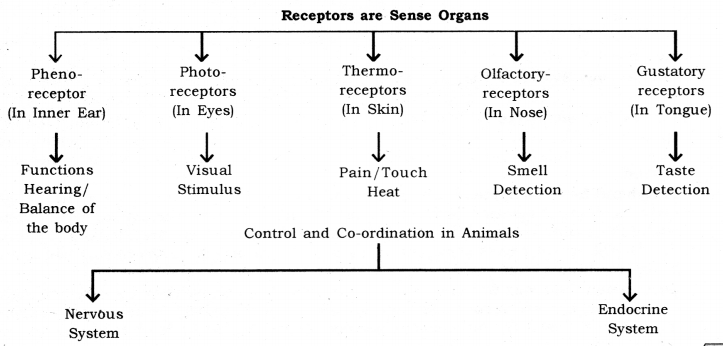
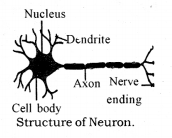
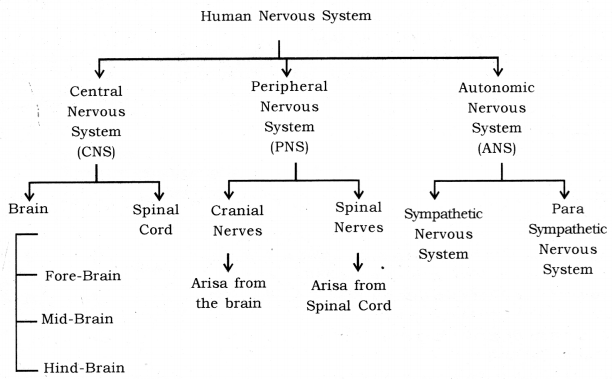
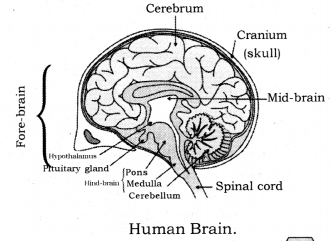
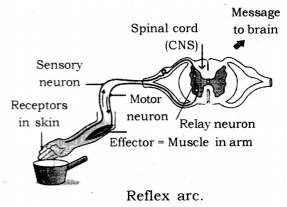
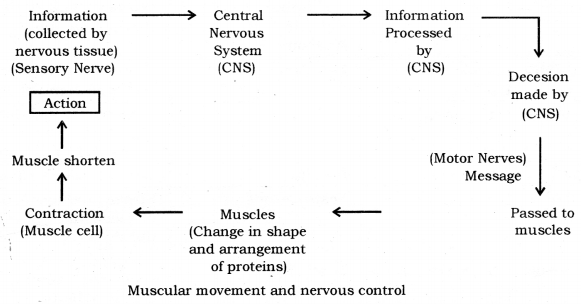
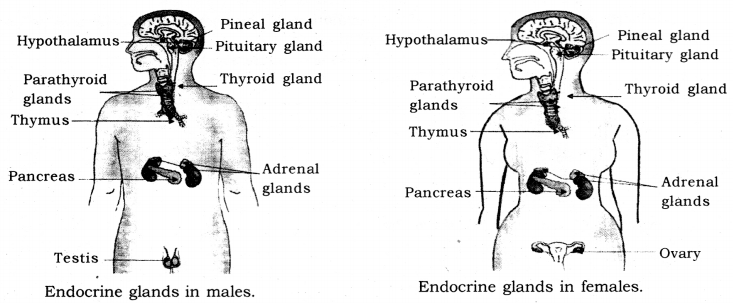
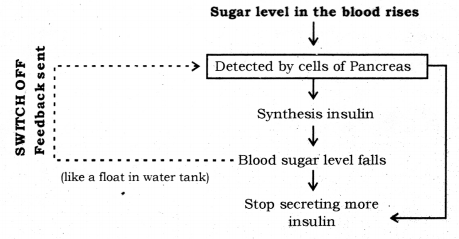


Leave a Reply